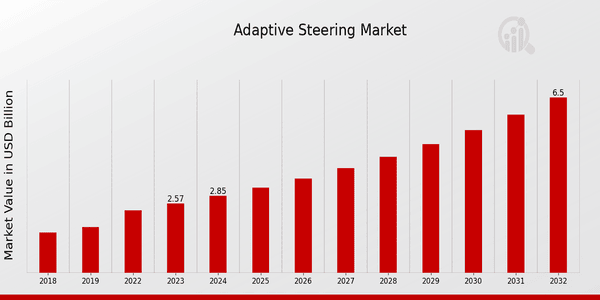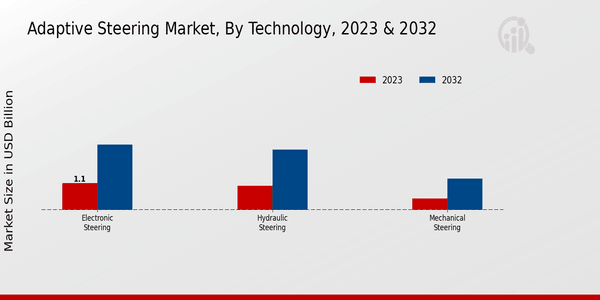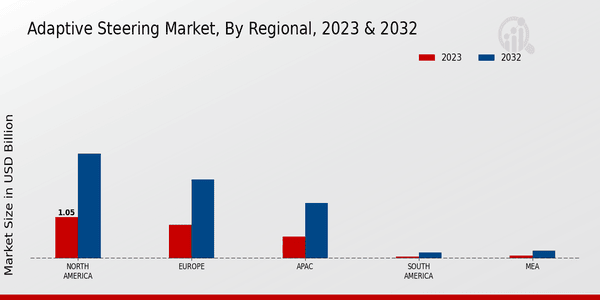Global Adaptive Steering Market Overview:
As per MRFR analysis, the Adaptive Steering Market Size was estimated at 3.16 (USD Billion) in 2024. The Adaptive Steering Market Industry is expected to grow from 3.51 (USD Billion) in 2025 to 8.88 (USD Billion) till 2034, at a CAGR (growth rate) is expected to be around 10.87% during the forecast period (2025 - 2034).
Key Adaptive Steering Market Trends Highlighted
The Adaptive Steering Market is witnessing significant growth driven by advancements in automotive technology and an increasing focus on enhancing driver comfort and safety. As consumer preferences shift towards more sophisticated vehicle features, manufacturers are compelled to integrate adaptive steering systems into their offerings.
These systems provide improved handling, better maneuverability, and enhanced safety, making them attractive to both manufacturers and end-users. Additionally, the rising demand for electric and autonomous vehicles is further propelling the market as adaptive steering plays a key role in the functionality and performance of these vehicles.
Opportunities exist in the untapped regions where automotive technology is still emerging. The demand for enhanced vehicle performance and comfort in developing markets is driving the need for innovative steering solutions.
Collaborations between technology companies and automotive manufacturers can lead to the development of advanced systems tailored to specific market needs. Moreover, the growing trend of smart cities and connected vehicles presents opportunities for integrating adaptive steering with other smart driving features, adding value to the overall driving experience.
In recent times, there has been a noticeable trend towards the integration of adaptive steering systems with advanced driver-assistance systems (ADAS).
This synergy not only improves overall vehicle control but also enhances vehicle safety by reducing the likelihood of accidents. The focus on sustainability is shaping the market, with manufacturers increasingly prioritizing lightweight materials and energy-efficient technologies in steering systems.
As the automotive landscape evolves, the adaptive steering market is positioned for continued growth driven by technological innovations and changing consumer demands. The future will likely see greater emphasis on seamless connectivity and integration with other vehicle systems, highlighting a transformative shift in how drivers interact with their vehicles.

Source: Primary Research, Secondary Research, MRFR Database and Analyst Review
Adaptive Steering Market Drivers
Technological Advancements in Automotive Engineering
The ongoing advancements in automotive engineering play a crucial role in driving the Global Adaptive Steering Market. As cars become more sophisticated, manufacturers are increasingly focusing on enhancing vehicle safety, comfort, and overall driving experience.
The integration of adaptive steering systems allows for improved vehicle control and maneuverability, particularly in complex driving conditions. These systems use sensors and electronic control units to adjust the steering ratio dynamically, providing drivers with the necessary feedback for better handling and stability.
Furthermore, as electric vehicles (EVs) gain traction in the market, the demand for innovative steering solutions, such as steer-by-wire technologies, is set to increase.
This transition not only ensures smoother driving experience but also aligns with stringent environmental regulations aimed at reducing carbon emissions. Additionally, the incorporation of advanced driver-assistance systems (ADAS) significantly complements the functionality of adaptive steering systems, thereby propelling market growth.
The synergy between autonomous driving technologies and adaptive steering innovations further illustrates the potential for growth in the Adaptive Steering Market as manufacturers develop solutions that prioritize safety, efficiency, and driver control.
As consumers increasingly seek vehicles equipped with cutting-edge technologies, the demand for adaptive steering systems is expected to rise, positioning this market for considerable expansion in the years to come.
Growing Demand for Enhanced Vehicle Safety Features
The growing demand for enhanced vehicle safety features significantly contributes to the expansion of the Global Adaptive Steering Market.
Consumers are becoming more aware of the importance of safety technologies in reducing the risk of accidents and improving overall driving experience. Adaptive steering systems offer advanced capabilities that enhance vehicle stability and response during challenging driving conditions, which aligns with consumer preferences for safer vehicles.
As a result, automotive manufacturers are prioritizing the integration of adaptive steering technologies to meet safety standards and consumer expectations.
Increasing Production of Electric Vehicles (EVs)
The increasing production of electric vehicles is driving the growth of the Global Adaptive Steering Market. As EV adoption accelerates globally, there is a rising need for innovative steering solutions that cater to the unique characteristics of electric powertrains.
Adaptive steering systems not only enhance the driving experience of EVs but also align with the overall trend towards more technologically advanced automotive features, creating a significant growth opportunity in this segment.
Adaptive Steering Market Segment Insights:
Adaptive Steering Market Technology Insights
The Adaptive Steering Market within the Technology segment is poised for significant growth, reflecting the broader trends of innovation in automotive systems aimed at enhancing vehicle dynamics and safety.
The market growth is primarily driven by advancements in vehicle technology, increasing focus on integrated safety measures, and the rise in demand for improved handling experiences in vehicles.
Within this sector, Electronic Steering emerged as a dominant force, valued at 1.1 USD Billion in 2023 and forecasted to increase to 2.7 USD Billion by 2032. This sub-segment is significant due to its ability to provide precise control and customization options, which appeal to the modern consumer seeking enhanced driving experiences.
The adoption of electronic steering systems is facilitated by their compact design and ease of integration with other smart technologies, thus making them a favorable choice for manufacturers aiming to innovate and upgrade their vehicle offerings.
Hydraulic Steering, with a market value of 1.0 USD Billion in 2023 and expected to rise to 2.5 USD Billion by 2032, played a crucial role as well. Its reliability and performance in various driving conditions have kept it relevant in the adaptive steering landscape.
Traditional hydraulic steering systems offer significant advantages in terms of feedback and response, thereby appealing to enthusiasts and commercial vehicles where higher levels of durability and dependability are paramount.
On the other hand, Mechanical Steering represented a smaller share of the market, with a valuation of 0.47 USD Billion in 2023 anticipated to expand to 1.3 USD Billion by 2032. Despite being the least dominant among the three, it remains integral due to its simplicity and lower maintenance requirements, particularly in cost-sensitive markets.
The growth in this sector suggests a continuing demand for basic, straightforward steering solutions in various vehicle types where advanced systems may not be economically viable.
The overall Adaptive Steering Market data indicates a strong trend towards electronic steering innovations, yet hydraulic and mechanical solutions maintain their relevance in addressing specific market needs.
As OEMs and consumers alike emphasize safety and ease of use, the market dynamics reflect a balanced growth among these technologies, each contributing uniquely to the evolving landscape of vehicle steering systems, supported by changing consumer preferences and regulatory pressures for safer, more efficient automotive technologies.
The Adaptive Steering Market Statistics underscore the importance of understanding this segmentation within the broader context of technological advancements shaping the future of automotive steering systems.

Source: Primary Research, Secondary Research, MRFR Database and Analyst Review
Adaptive Steering Market Vehicle Type Insights
The market segmentation reveals the pivotal role of Passenger Cars, Commercial Vehicles, and Heavy Duty Trucks, each contributing uniquely to market dynamics. Passenger Cars, being a dominant segment, are crucial as manufacturers focus on delivering responsive and safer driving experiences that align with consumer preferences.
Meanwhile, Commercial Vehicles play a significant role due to their extensive application in logistics and transportation, where adaptive steering enhances maneuverability. Heavy Duty Trucks represent another vital aspect, as advancements in adaptive steering technologies help improve control and safety during heavy load operations.
As a result, the Adaptive Steering Market is experiencing steady growth fueled by advancing technology and the pressing need for enhanced vehicle performance across these segments, reflecting significant market growth potential in the years ahead.
The market growth is further supported by trends emphasizing autonomous driving and increased safety regulations aimed at improving on-road experiences.
Adaptive Steering Market System Type Insights
The market segmentation includes various categories, such as Active Steering Systems, Passive Steering Systems, and Advanced Driver Assistance Systems. Active Steering Systems, by adjusting the steering response according to driving conditions, play a crucial role in enhancing maneuverability and safety.
Passive Steering Systems, while maintaining a more traditional approach, contribute substantially to driving comfort and control.
Advanced Driver Assistance Systems are becoming increasingly significant, offering features like lane-keeping assistance and collision avoidance, which enhance overall vehicle safety. The interplay between these systems continues to shape market trends, reflecting a growing demand for innovative vehicle technologies that support safer and more efficient driving experiences.
This growth trajectory presents various challenges, such as regulatory requirements and technological integration, while also creating opportunities for advancements in vehicle automation and user experience enhancement.
Overall, the Adaptive Steering Market data reveals a promising outlook driven by technological advancements and increasing consumer preferences for advanced safety features.
Adaptive Steering Market Application Insights
The Application segment plays a crucial role, contributing significantly to the evolving landscape of vehicle dynamics. Urban driving is essential as it caters to the increasing urbanization, where vehicles need adaptive technologies to navigate congested environments effectively.
Highway driving continues to dominate due to its demand for enhanced stability and maneuverability over long distances, representing a major share of market growth.
Off-road driving is also gaining traction, driven by the growing popularity of SUVs and off-road vehicles, which require specialized steering solutions to handle diverse terrains. The Adaptive Steering Market data reveals a collective movement towards smarter steering systems that improve safety, driving comfort, and fuel efficiency, creating substantial opportunities within these applications.
As consumers prioritize advanced driving experiences, the combined dynamics of urban and highway driving will likely steer the industry's growth trajectory, supported by ongoing innovations and changing consumer preferences.
The market growth is further reinforced by technological advancements and the automotive industry's shift towards automation, which all play integral roles in the Global Adaptive Steering Market.
Adaptive Steering Market Regional Insights
North America dominated the regional landscape, holding a valuation of 1.05 USD Billion in 2023 and projected to reach 2.65 USD Billion by 2032, driven by advanced automotive technology and a high concentration of automotive manufacturers.
Europe followed closely, holding a value of 0.85 USD Billion in 2023, with expectations to grow to 2.0 USD Billion, supported by increasing regulatory standards and consumer demand for safety features. In the APAC region, the market was valued at 0.55 USD Billion in 2023, with substantial growth anticipated to 1.4 USD Billion due to rising vehicle production and demand for enhanced driving experience.
South America and MEA held smaller market shares, with valuations of 0.05 USD Billion and 0.07 USD Billion in 2023, respectively, but are expected to grow to 0.15 USD Billion and 0.2 USD Billion by 2032, reflecting emerging market opportunities.
This varying landscape underlines the importance of regional dynamics influencing trends, such as technological advancement and infrastructure developments, shaping the overall Adaptive Steering Market revenue.

Source: Primary Research, Secondary Research, MRFR Database and Analyst Review
Adaptive Steering Market Key Players and Competitive Insights:
The Adaptive Steering Market is witnessing considerable growth driven by advancements in automotive technology and the increasing demand for enhanced driving comfort and vehicle maneuverability.
This market encompasses a blend of innovations aimed at improving steering responsiveness, allowing vehicles to adjust to varying driving conditions and enhancing overall safety. With the continuous evolution of autonomous driving technologies and the growing emphasis on integrating advanced driver-assistance systems (ADAS) within vehicles, the competition in this market is intensifying.
Key players are focusing on research and development to offer cutting-edge solutions that meet the demands of consumers and regulatory requirements, making competitive insights crucial for stakeholders looking to navigate this rapidly changing landscape.
General Motors has established a prominent presence in the Global Adaptive Steering Market, leveraging its extensive experience in automotive engineering and innovation.
The company excels in incorporating adaptive steering technologies into its diverse range of vehicle models, enhancing the overall driving experience for consumers. A key strength of General Motors is its commitment to safety and performance, which drives the integration of advanced steering systems designed to promote better control and agility.
Additionally, General Motors benefits from significant investments in research and development, allowing them to stay at the forefront of technological advancements and incorporate smart steering solutions in alignment with evolving market demands. This proactive approach ensures that General Motors maintains a competitive edge in the increasingly sophisticated adaptive steering domain.
Magna International is recognized as a formidable player in the Global Adaptive Steering Market, providing innovative solutions that meet the dynamic needs of the automotive sector. The company's robust capabilities in engineering and manufacturing adaptive steering systems position it as a key contributor to the advancement of steering technologies.
Magna International's strengths lie in its ability to combine expertise in design and production with a focus on sustainability and efficiency, which resonates well with contemporary automotive trends. Their commitment to collaboration with major automotive manufacturers enables the adoption of state-of-the-art adaptive steering functionalities across multiple vehicle platforms.
Through strategic partnerships and an emphasis on innovation, Magna International continues to solidify its role in shaping the future of the adaptive steering market, allowing vehicles to deliver enhanced handling characteristics and improved driver experiences.
Key Companies in the Adaptive Steering Market Include:
- General Motors
- Magna International
- Aisin Seiki
- Hirschvogel
- Robert Bosch
- Mando Corporation
- Thyssenkrupp
- Toyota Industries
- Continental
- ZF Friedrichshafen
- Nexteer Automotive
- Daimler AG
- Delphi Technologies
- Trelleborg AB
- JTEKT Corporation
Adaptive Steering Market Developments
The Adaptive Steering Market has seen significant recent developments, particularly among major players like General Motors and ZF Friedrichshafen, which are advancing their steering technologies to enhance vehicle safety and performance.
Companies such as Continental and Magna International are also innovating adaptive steering systems that aim to improve driver experience and vehicle responsiveness. Notably, the sector has been witnessing increased investments and partnerships aimed at product development and innovation.
In terms of mergers and acquisitions, Nexteer Automotive has been actively involved in expanding its market footprint, which aligns with the ongoing trend of consolidation in the industry.
This reflects a broader strategy among companies like Robert Bosch and Aisin Seiki to capture growth opportunities in the evolving automotive landscape. The adaptive steering market is forecasted to grow significantly, driven by rising consumer demand for advanced driver-assistance systems (ADAS), as well as regulatory pushes for improved vehicle safety.
As the market valuation rises, companies must adapt to shifts in customer expectations and integrate advanced technologies, which can influence future competition and alliances across the sector.
Adaptive Steering Market Segmentation Insights
- Adaptive Steering Market Technology Outlook
- Electronic Steering
- Hydraulic Steering
- Mechanical Steering
- Adaptive Steering Market Vehicle Type Outlook
- Passenger Cars
- Commercial Vehicles
- Heavy Duty Trucks
- Adaptive Steering Market System Type Outlook
- Active Steering Systems
- Passive Steering Systems
- Advanced Driver Assistance Systems
- Adaptive Steering Market Application Outlook
- Urban Driving
- Highway Driving
- Off-Road Driving
- Adaptive Steering Market Regional Outlook
- North America
- Europe
- South America
- Asia Pacific
- Middle East and Africa
| Report Attribute/Metric |
Details |
|
Market Size 2024
|
3.16 (USD Billion)
|
|
Market Size 2025
|
3.51 (USD Billion)
|
|
Market Size 2034
|
8.88 (USD Billion)
|
|
Compound Annual Growth Rate (CAGR)
|
10.87% (2025 - 2034)
|
|
Report Coverage
|
Revenue Forecast, Competitive Landscape, Growth Factors, and Trends
|
|
Base Year
|
2024
|
|
Market Forecast Period
|
2025 - 2034
|
|
Historical Data
|
2019 - 2023
|
| Market Forecast Units |
USD Billion |
| Key Companies Profiled |
General Motors, Magna International, Aisin Seiki, Hirschvogel, Robert Bosch, Mando Corporation, Thyssenkrupp, Toyota Industries, Continental, ZF Friedrichshafen, Nexteer Automotive, Daimler AG, Delphi Technologies, Trelleborg AB, JTEKT Corporation |
| Segments Covered |
Technology, Vehicle Type, System Type, Application, Regional |
| Key Market Opportunities |
Increased electric vehicle adoption, Advanced driver assistance systems integration, Rising consumer demand for safety, Technological advancements in steering systems, Expansion in emerging markets |
| Key Market Dynamics |
Technological advancements in steering systems, Increasing demand for vehicle safety features, Growth in electric and autonomous vehicles, Rising consumer preference for comfort, Stringent government regulations on vehicle safety |
| Countries Covered |
North America, Europe, APAC, South America, MEA |
Frequently Asked Questions (FAQ) :
The Adaptive Steering Market is projected to be valued at 8.88 USD Billion by 2034.
In 2024, the Adaptive Steering Market was valued at 3.16 USD Billion.
The expected CAGR for the Adaptive Steering Market from 2025 to 2034 is 10.87%.
North America is expected to have the largest market share, valued at 2.65 USD Billion by 2032.
The Electronic Steering technology segment is projected to be valued at 2.7 USD Billion by 2032.
Major players in the Adaptive Steering Market include General Motors, Magna International, Aisin Seiki, and Robert Bosch.
The Hydraulic Steering technology segment is anticipated to show significant growth, reaching 2.5 USD Billion by 2032.
In 2023, the Adaptive Steering Market in the APAC region was valued at 0.55 USD Billion.
The market presents growth opportunities driven by technological advancements and rising demand for enhanced vehicle safety features.
The Mechanical Steering technology segment is projected to reach a value of 1.3 USD Billion by 2032.

















